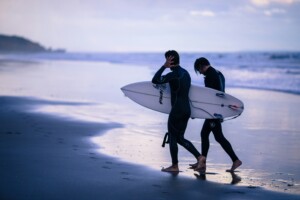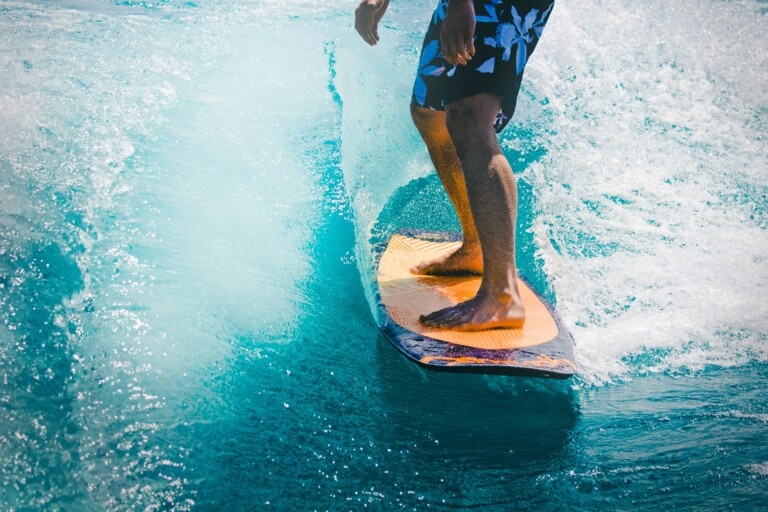There are some mornings when you wake up and just feel the need to surf. While this is always a good idea, there are days when you arrive at the beach, stoked to get in the water, only to find that the waves are small, closing out or choppy. Even though you can still have fun on a bad surf day, there are ways to check the surf ahead of time to see if it’s worth making the trip and choose the best beach breaks to optimize your time in the water.
BEFORE THE BEACH
If you are planning a surf sesh make sure to check the forecast because it will help give you an idea of the conditions for the day. The surf forecast will tell you about a few different components that will affect the conditions and therefore your experience if you decide to go surfing. While there are many factors that determine whether it will be a good or bad surf day, there are some common themes you’ll find in most forecasts. So when someone asks you, “What’s the surf like?” you can discuss the following topics:
WAVE HEIGHT
This will give you an idea of how big the waves will be during the day by offering a range of heights. A surf report might say that it will be 2-3 ft meaning the waves will be relatively small. This can help you determine if it will be a good day to surf or what kind of board to bring. If the reports says 1 ft, you can prepare for the possibility that the surf will not be great since it is hard to have well formed waves on a very small day. If you did decide to go out on a 1 ft day, a shortboard would not be the ideal board to bring. If the report however said 7-8ft, it might be a good idea to leave the longboard at home.
SWELL
There are a few different things to check when looking at the swell. Swells are groups of waves that travel from a storm offshore. Once they reach shallow water, swells form the waves that we surf. Swell size helps determine wave height. This is measured from the lowest point of the wave to the highest point. Usually, the bigger the height of the swell, the taller the wave. Swell periods help determine if the swell will create good, well formed waves. A swell period is the time it takes for continuous waves to pass through a certain point. They usually range from 1-20 seconds. The surf will probably be bigger and better the longer the swell period is, but of course there are other aspects to consider. The swell direction is also important because a swell needs to head in the direction of the shore in order to make waves. The waves will be larger the more the swell is directed towards the beach.
WIND
A surf report will give you the wind speeds for certain times of the day for both onshore and offshore winds. Moderate offshore winds create better surfing conditions while strong offshore winds will make it harder to surf. Onshore winds will tell you if the water will be blown out and choppy or if it will be glassy. The faster the wind speeds, the messier the waves will be, meaning they will not be shaped well. Less wind means better surfing conditions. Wind is usually slower in the mornings and evenings and picks up during the day.
TIDES
Tides affect the way that waves are shaped. There is a 12 hour tide period per day meaning tides go through a rising and falling cycle twice a day. This means that there are two low tides and two high tides a day. Both the low and high tide times will be given in the forecast. While it depends where you are surfing, it tends to be the best when the tide is rising from low to high which you can usually find in the morning or evening.
WATER TEMPERATURE
The water temperature will simply tell you how cold the water is so you can plan on what kind of wetsuit to bring or if it is warm enough to trunk it.
ON THE LOOKOUT
You may have seen surfers standing at the top of a sand dune looking out at the ocean. While they may just be appreciating nature, there is a good chance they are looking for the best place to paddle out. Once you have checked the forecast, decided to surf and have arrived to the beach, find a sand dune or stand at the shore to look for these things:
OTHER SURFERS
If you’re new at scoping the surf a quick trick is to find where other people are sitting on the outside. Chances are some of them knew what they were doing when they paddled out. You can sit with other surfers in the lineup while you learn but try not to get in their way when paddling out.
WHERE THE WAVES ARE BREAKING
This seems simple but check to see where the waves are breaking. Sets of waves will break in certain and consistent spots on the beach. To figure out where that is, just watch a set roll in before going out. Sets are groups of waves that break one after the other. After a set there will be a lull period where there are no waves. This calmer interval is a good time to paddle out because you don’t have to deal with the set waves crashing; you just have to make sure you reach the outside before the next set.
CHECK THE SHOULDERS
Waves will break in a certain direction that determine the way you’ll ride. This is called the shoulder and it is part of the wave that has not broken yet. When you are surfing, you ride from the peak of the wave onto the shoulder. A shoulder going right will favor surfers that have a regular stance while a left will favor goofy footed surfers. This does not mean that regular footed surfers should just look for rights and goofy surfers lefts; they’ll just be a little easier to catch because of the direction you are facing.
CURRENTS
There are a lot of different kinds of currents in the ocean. Two very prevalent ones are longshore currents and rip currents. Longshore currents are ones that pull you north and south down the beach. These currents are the reason that you drift when you are hanging out in the water. Look for these currents before you surf to see which way the current is going so you don’t end up drifting down to a different surf spot. Rip currents are the ones that pull you past the break. These currents can be dangerous at some beaches so make sure to look closely to see if any seem strong enough to pull you out to sea. While they can be dangerous, rip currents can also help you get to the outside. When you find it, you can ride it out so you don’t have to paddle over the waves so much.
Now you can prepare for your time in the water and when you feel like surfing, you can check the conditions to know if it’s the right day for you. The next time you are asked, “Hey what’s the surf like?” you can give a step by step explanation of all the things surfers look for before they paddle out.
















